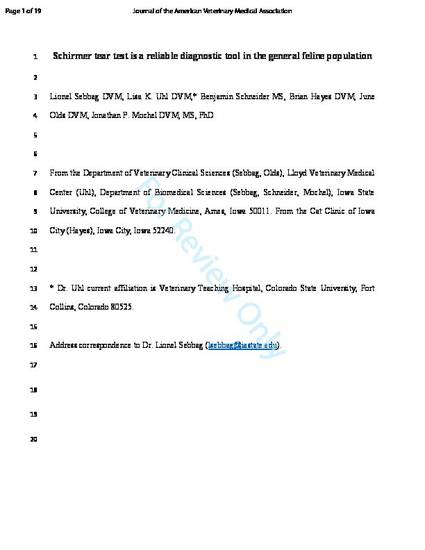
Article
Schirmer tear test is a reliable diagnostic tool in the general 1 feline population
Journal of the American Veterinary Medical Association
(2018)
Abstract
Objective. To test whether Schirmer tear test-1 (STT-1) can be falsely decreased in anxious cats and evaluate the feasibility of shorter duration testing in this species. Design. Prospective cross-sectional study. Animals. 176 cats examined in private practice (n = 100), feral clinic (n = 56) and teaching hospital (n = 20). Procedures. STT-1 was performed in both eyes of each cat, recording values in mm every 10-30 sec for 1 minute. STT-1 was performed twice at the teaching hospital – 30min apart – in a stress-free room (non-stimulated) and a loud stressful environment (stimulated), evaluating the cats’ heart rate pre- and post- STT collection. Data was analyzed with conventional statistics and a nonlinear mixed effect model. Results. STT-1 at 30 and 60 sec were strongly correlated (r = 0.94, P < 0.001). No significant differences were found between STT-1 values of non-stimulated and stimulated environments (P ≥ 0.167) despite significant changes in heart rate (P < 0.001) that indicated sympathetic nervous stimulation. A hyperbolic model of STT-1 kinetics was validated, allowing for extrapolation of readings obtained in <60 sec and generation of reference values at various times. Median (95% predictive interval) STT-1 at 30 and 60 seconds were 9.1 mm/30 sec and 14.3 mm/min, respectively. Conclusions and Clinical Relevance. STT is not affected by sympathetic stimulation in cats, and a shorter test duration of testing could be considered if needed (uncooperative patient).
Disciplines
Publication Date
Fall 2018
Citation Information
Jonathan P. Mochel. "Schirmer tear test is a reliable diagnostic tool in the general 1 feline population" Journal of the American Veterinary Medical Association (2018) Available at: http://works.bepress.com/jonathan-mochel/24/
